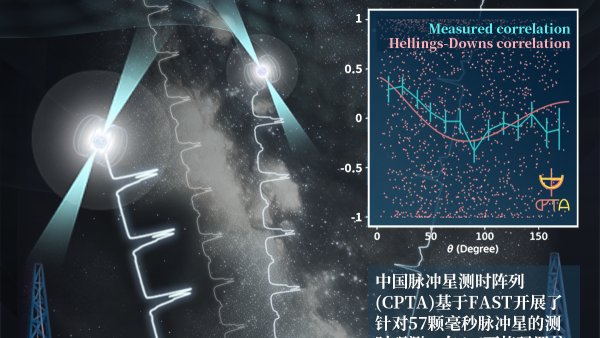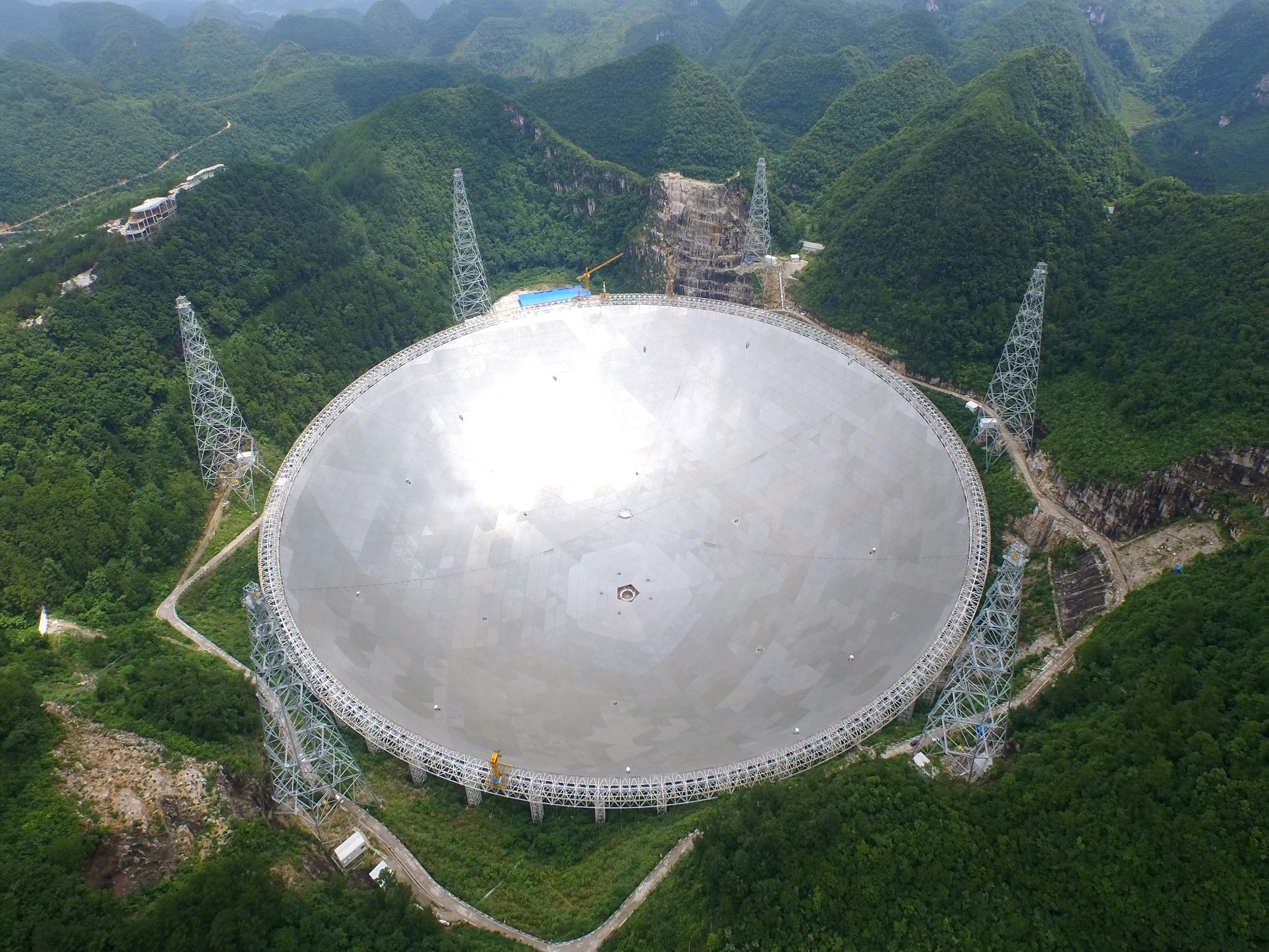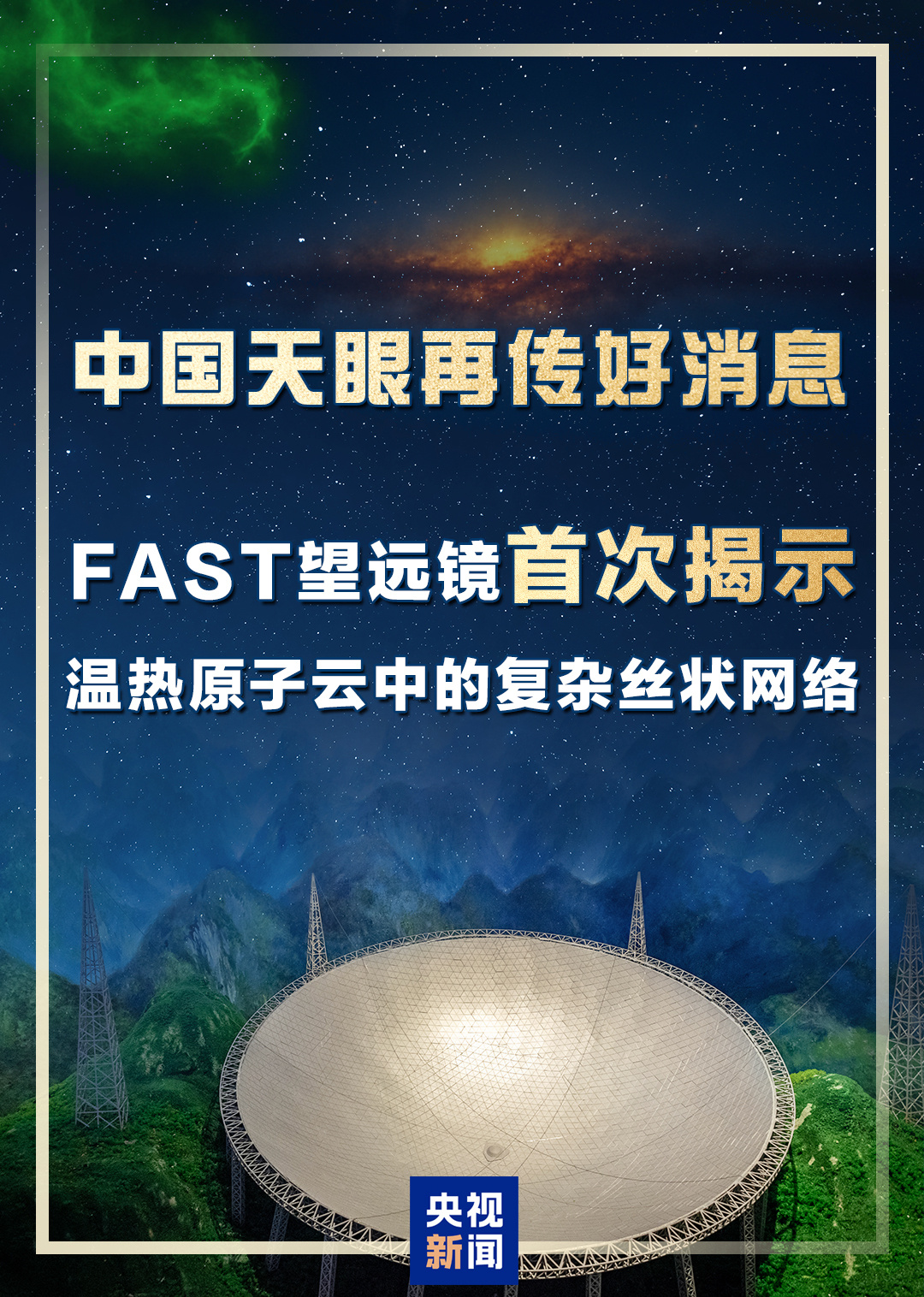

Recently, the news of "Recovering a world-class discovery! China's sky eye 'saw' traces of nanohertz gravitational waves" spread across the screen. This is considered to be one of the most important recent research achievements of scientific research institutions such as the National Astronomical Observatory of the Chinese Academy of Sciences ("National Astronomical Observatory").
Why is it called a world-class discovery? What are nanohertz gravitational waves? what's it for? How it was discovered...
In order to understand this latest research result, The Paper recently interviewed Dr. Xu Heng, the first author of the relevant paper, an assistant researcher at the National Astronomical Observatory, and a "post-90s generation".
Hertz is the number of times a periodic event occurs per second. Hertz means one hundred times per second, and nanohertz means 10^-9 times per second ( one billionth ), which equates to about one event in 31 years.
Xu Heng told The Paper that nanohertz gravitational waves are low-frequency gravitational waves, on the order of 10^-9 Hz. Its cycle is very long, and it may take years or even decades to "complete" a cycle. Gravitational waves carry a lot of important information from celestial bodies in the universe, but detecting gravitational waves is very difficult, approaching the limit of existing technological capabilities. Every time humans detect gravitational waves so far, it is considered a remarkable achievement. Previously, the detection and research on gravitational waves has won the Nobel Prize twice.

Li Kejia, a researcher at the National Astronomical Observatory/Peking University, is the corresponding author of the nanohertz gravitational wave paper. Map of the National Astronomical Observatory of the Chinese Academy of Sciences
A galaxy-sized detector flying in space - a pulsar timing array, an extremely sensitive radio telescope - "Chinese Sky Eye" FAST (500-meter aperture spherical radio telescope), a group of dedicated to exploring the starry sky and the universe The mysterious scientist may be the key to the breakthrough of Chinese scientists in the field of nanohertz gravitational waves.
Xu Heng said that the detection of nanohertz gravitational waves this time is a "0 to 1" discovery. But it cannot be said that we have directly seen Nahertz gravitational waves. At present, the first phase of research has been basically completed, and the second phase of research will start to improve the accuracy of the results and extract information from gravitational waves .
Related papers were published online on June 29 in the international academic journal Research in Astronomy and Astrophysics (RAA, Research in Astronomy and Astrophysics) established by the National Astronomical Observatory. The corresponding author of the paper is Li Kejia, a researcher at the National Astronomical Observatory/Peking University.
Xu Heng said that the paper of this important achievement was published in a domestic journal, hoping to support the development of domestic academic journals. Three other international teams abroad also independently published papers with similar results in different journals at the same time as agreed.

Dr. Xu Heng, the first author of the Nahertz gravitational wave paper, assistant researcher of the National Astronomical Observatory, and "post-90s". Map of the National Astronomical Observatory of the Chinese Academy of Sciences
Why it is a world-class discovery: Exploring the new wave band of the universe
"The primary purpose of our study of nanohertz gravitational waves is not to warn black holes or detect dark matter. From the perspective of all mankind, the detection of gravitational waves is a very important ability and a very important breakthrough." Xu Heng said.
Astronomy is the observation and visualization of worlds far beyond human imagination. When space-time is disturbed, gravitational waves are produced. It is "ripples" that have effects in all directions and decay as they travel across the vastness of space. It is produced by an accelerating mass object disturbing the surrounding space-time and is transmitted as gravitational radiation.
Xu Heng told The Paper that more than 100 years ago, Einstein published the general theory of relativity and predicted the existence of gravitational waves, but he himself did not believe that gravitational waves could be detected because the signal was too weak. However, this does not affect scientists' enthusiasm for gravitational wave research, because it is so important.
Scientists have won two Nobel Prizes for the detection of gravitational waves. The gravitational wave detection was awarded the Nobel Prize for the first time by Russell A. Hulse and Joseph H. Taylor Jr. of the Princeton University in New Jersey in the seventies of the last century. In the 1980s, they indirectly proved the existence of gravitational waves by observing pulsar binary stars, and the two won the 1993 Nobel Prize in Physics for this reason; Taiwan) facilities directly detected high-frequency gravitational waves in the 100 Hz frequency band. Therefore, American scientists Rainer Weiss, Barry C. Barish and Kip S. Thorne won the 2017 Nobel Prize in Physics.
"This time we have detected evidence of (nahertz) gravitational waves in the nanohertz frequency band. This is indeed a very important progress in physics." Xu Heng said.

The gravitational waves generated by the most massive celestial bodies in the universe, such as the supermassive double black hole system with a mass of 100 million to 100 billion times the sun's mass in the center of the galaxy, are mainly concentrated in the nanohertz frequency band. Xu Heng introduced, "What we are detecting now is actually the background of gravitational waves—that is, the background of the superposition of countless nanohertz gravitational waves." National Astronomical Observatories, Chinese Academy of Sciences
He said, "In fact, gravitational waves carry many astrophysical signals. After detecting gravitational waves, you can study these astrophysical signals. For example, high-frequency gravitational waves may be produced by the merger of black holes with tens of times the mass of the sun. , but low-frequency gravitational waves such as nanohertz gravitational waves may be caused by the merger of supermassive black holes, such as black holes with a mass of 100 million times, 1 billion times, and 100 billion times the sun. By studying the evolution and merger of these supermassive double black holes, Maybe you can deduce 'how galaxies evolve and merge', and you can know how our universe evolves. "
In other words, just like knowing the past, perhaps knowing the future , insight into more mysteries of the universe may reveal our future destiny and bring us new enlightenment .
In 2017, the Nobel Prize official website stated that gravitational waves have opened a new era of observing the universe . "From Galileo's observation of the starry sky 400 years ago to today, the way we observe the universe has undergone tremendous changes. I am looking forward to greater progress." Nobel Laureate in Physics, Caltech Feynman Theoretical Physics Professor Kip Thorne said during a lecture at Beijing Normal University in December 2017. He also predicted that in the next 15 to 20 years, observation windows for four different gravitational wave bands will be opened.
Nanohertz gravitational waves are gravitational waves in the low-frequency band. Compared with the high-frequency gravitational waves detected by LIGO before, they have a different generation mechanism, and they also carry information about different cosmic objects.
The gravitational waves generated by the most massive celestial bodies in the universe, such as the supermassive double black hole system with a mass of 100 million to 100 billion times the sun's mass in the center of the galaxy, are mainly concentrated in the nanohertz frequency band . In this frequency band, there are also the surviving parts of the original gravitational waves in the early universe and the gravitational waves produced by strange objects such as cosmic strings.
But the challenge is to be able to detect and record these gravitational waves first.
Xu Heng told The Paper that gravitational waves are very difficult to detect. It is a weak signal detection, which is close to the limit of human's existing technological capabilities, and also reflects the scientific and technological level of a country or nation, and even all mankind. The magnitude of the nanohertz gravitational waves detected so far is extremely small, the distance is equivalent to the disturbance caused by the gravitational wave at the scale of 1 km is about the size of one percent of a hydrogen atom, and the time is equivalent to a change of 1 second on the scale of tens of millions of years .
Xu Heng said that this astonishing detection accuracy and detection capability "is indeed pushing the limits of human beings. (This measurement capability) can also do quite a lot of things, such as studying the turbulence of the Milky Way and the dynamics of the solar system. , Measuring the mass of planets in the solar system, etc." "So, the detection of nanohertz gravitational waves is very important, and it is also the direction that many international colleagues are working on."
"The detection of nanohertz gravitational waves is a '0 to 1' breakthrough . After you have this thing, open this window, you can look back and do more things, but what is behind, we I don’t know yet,” Xu Heng said.
Li Kejia, the corresponding author of the paper and a researcher at the National Astronomical Observatory/Peking University, said at the press conference on the research results of nanohertz gravitational waves, "Humanity is finally standing in front of the long-awaited observation window of nanohertz gravitational waves." "We use The large scientific installations independently designed and built by China carry out original research, and the results are published in Chinese academic journals, and our country has reached the leading level in this field at the same time as the world."
It is not yet possible to say that we have directly seen nanohertz gravitational waves
Xu Heng emphasized to Pengpai Technology that for the sake of rigor, it cannot be said that the Nahertz gravitational wave has been directly "seen", but it should be said that the detection of the "direct evidence" and "key evidence" of the existence of the Nahertz gravitational wave. "With a little more data accuracy, we can confidently say that we have directly detected nanohertz gravitational waves. We will have to wait a few more months, or years."
According to reports, the Chinese research team analyzed and studied the signal data collected by FAST based on independently developed software, and found evidence of quadrupole-related signals with nanohertz gravitational wave characteristics at a confidence level of 4.6 sigma.
Xu Heng told The Paper, "The gold standard in physics is 5 sigma (confidence level), and we are now at 4.6 sigma, which is still a bit short. Therefore, we conservatively say that the key evidence for the existence of nanohertz gravitational waves is detected." , direct evidence, rather than directly seeing nanohertz gravitational waves." "It would be more rigorous to say that." "Several independent international teams have detected similar signals and verified the results with each other."
The false positive rate at the 4.6 sigma confidence level is already less than 1 in 500,000. This is a high-precision result obtained after analyzing and researching only 3 years and 5 months of data collected by FAST so far, and its confidence level is higher than that of international counterparts in Europe, North America and Australia.
Xu Heng said that with the continuous development of observations at FAST and the continuous accumulation of data, the accuracy of future results will be greatly improved. "We will continue to observe in the future and extend the time span of the data. The sensitivity of detecting nanohertz gravitational waves will increase rapidly with the increase of the time data length. For example, if the data is doubled, the sensitivity will increase several times." "Three years." Within, (reaching 5 Sigma) should be fine."
Xu Heng introduced that foreign counterparts have been using other large radio telescopes since around 2000 to collect data and search for evidence of the existence of nanohertz gravitational waves. "In more than three years, we have reached a level similar to theirs."
Xu Heng introduced, " What we are detecting now is actually the background of gravitational waves —that is, the background of the superposition of countless nanohertz gravitational waves . Because gravitational waves are too weak, it is difficult to directly detect a single gravitational wave." So everyone’s first step is to directly detect this background, and then consider a single gravitational wave.”
Xu Heng told The Paper, "Now our team is putting a lot of effort into doing this - to detect a single gravitational wave signal."

"China Sky Eye" FAST (500-meter Aperture Spherical Radio Telescope). Map of the National Astronomical Observatory of the Chinese Academy of Sciences
Milky Way-Sized 'Natural' Detector
Previously, the instrument used by humans to measure gravitational waves was a laser interferometer built on the earth.
There are two gravitational-wave detector LIGO facilities in the United States, and the new round of upgrades alone costs tens of millions of dollars. In 2019, the US National Science Foundation (NSF) and the UK Research and Innovation Center (UKRI) funded LIGO operators with US$20.4 million and US$14.1 million, respectively.
LIGO stands for "Laser Interferometer Gravitational-wave Observatory" (Laser Interferometer Gravitational-wave Observatory), which were built in Hanford, Washington, USA, and Livingston, Louisiana, about 3,000 kilometers away. They were completed in 2008, successfully debugged in 2015, and detected gravitational waves in the 100 Hz frequency band that year, and were officially announced in 2016. The previously detected gravitational waves were generated by the violent collision of two black holes with a mass of 30 to 60 times the sun, 1.3 billion light-years away from the earth.
The full name of the European gravitational-wave detector Virgo is "Virgo Gravitational-Wave Observatory", which was jointly participated by scientists from France, Italy, the Netherlands, Poland, Hungary and Spain. In 2003, it was built in Cascina, a small town near Pisa, Italy.
Compared with the ground-based gravitational wave detectors with huge projects in the United States and Europe, Chinese scientists' detectors for detecting nanohertz gravitational waves fly in space, which is larger and more "natural".
Xu Heng said, " If you want to measure the width of your palm , you can measure it with a ruler. The wavelength of high-frequency gravitational waves may be on the order of tens of kilometers. If you build a detector of several kilometers on the earth, you can measure it." But the wavelength of nanohertz gravitational waves is too long. Its cycle is in years, and the corresponding wavelength may reach several light-years. One light-year is equivalent to 9.46 trillion kilometers. The diameter of the earth is only more than 10,000 kilometers. There is no way to make a detector that big."
So, how large a detector can observe nanohertz gravitational waves?
Xu Heng said, "A detector with a span of at least tens of light years." "So we can only look for it in the universe. We use radio telescopes to monitor multiple pulsars with extremely stable rotation for a long time, forming an array. Such a galactic-scale detector can measure nanohertz gravitational waves."
The 57 pulsars selected for the aforementioned detectors are all millisecond pulsars. A pulsar is the "remains" of a massive star after its death. It is a strange and compact star with extremely high density, extremely high magnetic field, and high-speed rotation that emits radio pulses. 1 second equals 1000 milliseconds. Pulsars with a rotation period of 1-30 milliseconds are called millisecond pulsars. It emits radio pulses whose "times" are as accurate as the best atomic clocks on Earth.
Xu Heng introduced, " It is not necessary to have 57 (pulsars) , but to basically add the pulsars with relatively high timing accuracy that FAST can see into the pulsar timing array, so as to improve the pulsar timing. The accuracy of the array. At this stage, we have 57 in the data."
Xu Heng said that pulsars can exist for tens of millions of years, and their "travel time" is also very accurate. However, when the gravitational wave comes, it disturbs the space-time, causing some pulse signals from pulsars to arrive late, while others arrive earlier. These are extremely small changes. But if the correlation of these signal data conforms to the quadrupole correlation curve, then people can think that these disturbances are caused by nanohertz gravitational waves.
Xu Heng said that a visual description of the discovery process of nanohertz gravitational waves is that FAST has been staring at 57 pulsars in space, continuously recording the pulse signals from them, and recording the "natural" detector's " reading". After staring at it for 3 years and 5 months, scientists discovered the key evidence of the existence of nanohertz gravitational waves through calculations in the massive data.
If the study of Nahertz gravitational waves is divided into two stages, Xu Heng said that the first stage-"detection of gravitational waves" is almost completed, and now the second stage-"extracting information, and then delve into the universe.” He said that this process is like the creation of computers from scratch by human beings. Although the computers at that time were huge and had a single function, to today's smart phones and computers with rich functions and powerful computing power, it has also experienced a lot of changes. The development time is very long, and they hope to cross this process as soon as possible, and fully open the door to observe the universe through nanohertz gravitational waves as soon as possible.
The Chinese Pulsar Timing Array (CPTA) research team composed of National Astronomical Observatory/Peking University researcher Li Kejia and other researchers reported the aforementioned nanohertz gravitational wave results. Gravitational Wave Background (Searching for the Nano-Hertz Stochastic Gravitational Wave Background with the Chinese Pulsar Timing Array Data Release I).
Internationally, other pulsar timing array cooperation groups, including European EPTA-Indian InPTA, North American NANOGrav and Australian PPTA also announced similar results on the same day, June 29. Results of four international independent studies mutually corroborate this finding.
According to reports, the detection of gravitational waves with a frequency as low as nanohertz will help astronomers understand the origin of the structure of the universe, and detect the growth, evolution and merger process of the most massive celestial body in the universe, that is, the supermassive black hole; it will also help Physicists gain insight into the fundamental physical principles of spacetime. Through the data analysis software independently developed by Chinese scientists, the advantages of data accuracy, number of pulsars and data processing algorithms have made up for the gap in the time span, and the detection sensitivity of nanohertz gravitational waves in my country has quickly reached the same level as that of the United States, Europe and Australia. A considerable level, so as to achieve this major scientific breakthrough at the same time. However, limited by the short time span of the current observation data, the Chinese scientific research team is temporarily unable to determine the main physical source of gravitational waves in the nanohertz band, but this will be resolved as the time span of follow-up observation data increases.
According to the information on the official website of the National Astronomical Observatory, the institution was established in April 2001 and its headquarters is located in Beijing. Artificial Satellite Observatory. The Purple Mountain Observatory of the Chinese Academy of Sciences and the Shanghai Astronomical Observatory are subject to the macro-coordination and guidance of the National Astronomical Observatory for their major disciplines, operation of large-scale observation equipment, and construction of observation bases.
The National Astronomical Observatory has built and operated a number of internationally leading important observation equipment represented by the Guo Shoujing Telescope (LAMOST) and the "China Sky Eye" FAST.
The National Astronomical Observatory founded the international excellent astronomy journal "Research in Astronomy and Astrophysics" (RAA, Research in Astronomy and Astrophysics) with independent intellectual property rights, and established a popular science publication with the concept of "facing the general public, combining astronomy and humanities" "China National Astronomy" magazine.
Attached paper link: https://doi.org/10.1088/1674-4527/acdfa5


